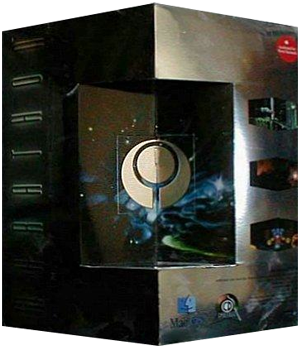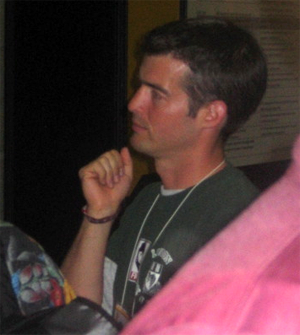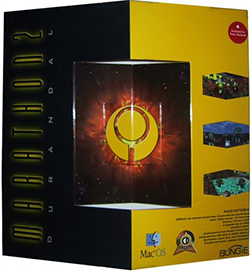
The Marathon Trilogy is a science fiction first-person shooter video game series from Bungie, originally released for the Classic Mac OS. The name of the series is derived from the giant interstellar colony ship that provides the main setting for the first game; the ship is constructed out of the Martian moon Deimos. The series is often regarded as a spiritual predecessor of Bungie's Halo series.

Halo: Combat Evolved is a 2001 first-person shooter video game developed by Bungie and published by Microsoft Game Studios for the Xbox. It was released as a launch game for Microsoft's Xbox video game console on November 15, 2001. The game was ported to Microsoft Windows and Mac OS X in 2003. It was later released as a downloadable Xbox Original for the Xbox 360. Halo is set in the twenty-sixth century, with the player assuming the role of the Master Chief, a cybernetically enhanced supersoldier. The Chief is accompanied by Cortana, an artificial intelligence. Players battle aliens as they attempt to uncover the secrets of the eponymous Halo, a ring-shaped artificial world.

Halo 2 is a 2004 first-person shooter game developed by Bungie and published by Microsoft Game Studios for the Xbox console. Halo 2 is the second installment in the Halo franchise and the sequel to 2001's critically acclaimed Halo: Combat Evolved. The game features new weapons, enemies, and vehicles, another player character, and shipped with online multiplayer via Microsoft's Xbox Live service. In Halo 2's story mode, the player assumes the roles of the human Master Chief and alien Arbiter in a 26th-century conflict between the United Nations Space Command, the genocidal Covenant, and later, the parasitic Flood.

The Flood is a fictional parasitic alien lifeform and one of the primary antagonists in the Halo multimedia franchise. First introduced in the 2001 video game Halo: Combat Evolved, it returns in later entries in the series such as Halo 2, Halo 3, and Halo Wars. The Flood is driven by a desire to infect any sentient life of sufficient size; Flood-infected creatures, also called Flood, in turn can infect other hosts. The parasite is depicted as such a threat that the ancient Forerunners constructed artificial ringworld superweapons known as Halos to contain it and, as a last resort, to kill all sentient life in the galaxy in an effort to stop the Flood's spread by starving it.

Halo 3 is a 2007 first-person shooter video game developed by Bungie for the Xbox 360 console. The third installment in the Halo franchise following Halo: Combat Evolved (2001) and Halo 2 (2004), the game's story centers on the interstellar war between 26th-century humanity, a collection of alien races known as the Covenant, and the alien parasite known as the Flood. The player assumes the role of the Master Chief, a cybernetically enhanced supersoldier, as he battles the Covenant and the Flood. In cooperative play, other human players assume the role of allied alien soldiers. The game features vehicles, weapons, and gameplay elements familiar and new to the series, as well as the addition of saved gameplay films, file sharing, and the Forge map editor—a utility which allows the player to perform modifications to multiplayer levels.

Airburst is a video game developed by Strange Flavour and published by Freeverse for Mac OS. On October 25, 2007, it was announced for Xbox Live Arcade game for the Xbox 360. The Xbox 360 release was canceled but the game was available for testing on Partnernet, the private Xbox 360 developer site. Partnernet was shut down around 2017 after the release of the Xbox 1.

Marathon Infinity is a first-person shooter video game, the third in the science fiction Marathon Trilogy by Bungie. The game was released on October 15, 1996 and included more levels than its predecessor Marathon 2: Durandal. These levels were larger, and formed part of a more intricate plot. Marathon Infinity, unlike Marathon 2, was originally released only for the Apple Macintosh. However, Bungie released the source for Marathon 2 in 1999, allowing the development of the open-source multiplatform Aleph One engine that is also compatible with Infinity. In 2005, Bungie released the trilogy to the public as freeware, allowing the games to be freely downloaded. In 2011, Bungie released the source code for Marathon Infinity itself, preceding an official Aleph One-based port for iOS the next year that is available free.

Marathon is a first-person shooter video game developed and published by Bungie, and released in December 1994 for the Apple Macintosh. The game takes place several centuries into the future in outer space and sets the player as a security officer attempting to stop an alien invasion aboard a colony ship named the Marathon.

Jason Jones is an American video game developer and programmer who co-founded the video game studio Bungie with Alex Seropian in 1991. Jones began programming on Apple computers in high school, assembling a multiplayer game called Minotaur: The Labyrinths of Crete. While attending the University of Chicago, Jones met Seropian and the two formed a partnership to publish Minotaur.

Pinball FX is a pinball machine video game for the Xbox 360. It was developed by Zen Studios and published by Microsoft Game Studios. It was released on April 25, 2007 via the Xbox Live Arcade service. The game features three tables, with six more available as downloadable content, leaderboards and online multiplayer. A sequel to the game, Pinball FX 2 was released on October 27, 2010.

Undertow is a video game developed by Chair Entertainment for the Xbox 360's Xbox Live Arcade service.
Excalibur: Morgana's Revenge is a first-person shooter video game developed by ExcaliburWorld Software. The game's development has been closely tied to the Marathon and later Aleph One engines, on which it is based. Most recently, the game was expanded and re-released in 2007 for OS X, Microsoft Windows, and Linux using the open-source Aleph One engine.

Halo 3: ODST is a 2009 first-person shooter game developed by Bungie and published by Microsoft Game Studios. The fifth installment in the Halo franchise as a side game, it was released on the Xbox 360 in September 2009. Players assume the roles of United Nations Space Command Marines, known as "Orbital Drop Shock Troopers" or ODSTs, during and after the events of Halo 2. In the game's campaign mode, players explore the ruined city of New Mombasa to discover what happened to their missing teammates in the midst of an alien invasion. In the "Firefight" multiplayer option, players battle increasingly difficult waves of enemies to score points and survive as long as possible; Halo 3's multiplayer is contained on a separate disc packaged with ODST.

Halo: Reach is a 2010 first-person shooter video game developed by Bungie and published by Microsoft Game Studios, originally for the Xbox 360. The sixth installment in the Halo series and a direct prequel to Halo: Combat Evolved, Reach was released worldwide in September 2010. The game takes place in the year 2552, where humanity is locked in a war with an alien theocracy known as the Covenant, which seeks to exterminate humanity. Players play as Noble Six, a member of an elite supersoldier squad, known as the Spartans, attempting to stage a defense of the human world known as Reach, which falls under Covenant attack. The game was the last in the series to be developed by Bungie.
Bungie, Inc. is an American video game company based in Bellevue, Washington, and a subsidiary of Sony Interactive Entertainment. The company was established in May 1991 by Alex Seropian, who later brought in programmer Jason Jones after publishing Jones's game Minotaur: The Labyrinths of Crete. Originally based in Chicago, Illinois, the company concentrated on Macintosh games during its early years and created two successful video game franchises called Marathon and Myth. An offshoot studio, Bungie West, produced Oni, published in 2001 and owned by Take-Two Interactive, which held a 19.9% ownership stake at the time.

Alien Breed 2: Assault is a video game in Team17's Alien Breed series and is the second new title in the series since 1996 after Alien Breed Evolution. It was released on Steam, Xbox Live Arcade, and PlayStation Network in 2010. The follow-up Alien Breed 3: Descent was released on 17 November 2010.

Perfect Dark is a 2010 first-person shooter developed by 4J Studios and published by Microsoft Game Studios for the Xbox 360 through its Xbox Live Arcade download service. The game is a remaster of the original Perfect Dark, which was released for the Nintendo 64 in 2000. Although the gameplay remains largely unchanged, the remaster features significant technical improvements over the original, including new higher-resolution textures and character models, a higher frame rate, and a multiplayer mode that supports the Xbox Live online service. The story of the game follows Joanna Dark, an agent of the Carrington Institute organization, as she attempts to stop a conspiracy by rival corporation dataDyne.

Section 8: Prejudice is a science fiction, first-person shooter video game developed by TimeGate Studios. It is the direct sequel to the 2009 game Section 8. Unlike its predecessor, Prejudice is a digital download-only title that contains more content than the previous game. It was released for Xbox 360 on April 20, 2011, for Microsoft Windows May 4, 2011, and for PlayStation 3 in North America on July 26, 2011, and in the PAL region on August 3, 2011

Alien Rage is a 2013 first-person shooter video game for Microsoft Windows, Xbox 360, and PlayStation 3 developed by CI Games, then known as City Interactive, using Unreal Engine 3. The game has single-player and competitive multiplayer modes. In its single player campaign, players are put in control of an elite soldier named Jack which is sent to destroy a mining facility and its aliens after they turned against and killed the humans that they had shared the facility with.
















